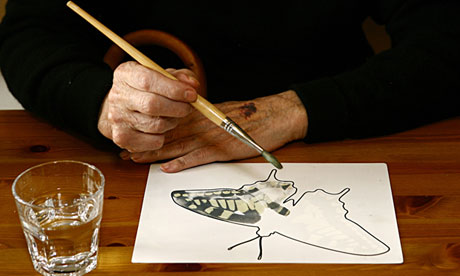A creative approach to helping people with dementia
Active Minds designs products to improve the quality of life of those with the condition – from jigsaw puzzles to painting books

A person paints one of the pictures in the painting book produced by Active Minds. Photograph: Active Minds
There are 800,000 people in the UK living with dementia. It requires complex treatment and there is an ongoing debate as to how best to ensure a good standard of living for people with the condition.
Recent research from the Department of Health and Alzheimer's UK has argued for an activities based approach when caring for people with dementia. Activities such as painting have been proven to help people reconnect with their surroundings and lessen their dependency on anti-psychotic drugs.
This treatment requires time and attention in the short term, but produces tangible results. However, already stretched families and care professionals lack adequate resources to deliver this kind of care, making it harder than it needs to be.
I have experienced the difficulties carers face first hand. Fifteen years ago, my grandfather was diagnosed with Alzheimer's. As he became less mobile, the activities available to him were more sedentary and he became a jigsaw enthusiast. As his ability to complete puzzles diminished, they got simpler until children's toys were being used. This situation is reflected in many care homes, with children's activities being used or carers having to devise their own. I saw a simple need that was not being met. As a designer I decided that I could use my skills alongside the experience of those in the care sector to develop activities capable of delivering age-appropriate dementia care.
 Active Minds jigsaw puzzle and painting book. Photograph: Active Minds The obvious place to start was my grandfather's puzzles. I asked myself a range of questions: what was the optimum size of piece for elderly hands; what images would be resonant; what special features would it need so that it could be used unassisted? I consulted carers in a local home and the head of dementia care at St George's hospital. During one testing session in a care home, a resident, who hadn't spoken all day began talking about his time in the war as he completed a puzzle with a picture of a Spitfire. This first success laid the groundwork for Active Minds, my dedicated range of activities designed for people with dementia.
Active Minds jigsaw puzzle and painting book. Photograph: Active Minds The obvious place to start was my grandfather's puzzles. I asked myself a range of questions: what was the optimum size of piece for elderly hands; what images would be resonant; what special features would it need so that it could be used unassisted? I consulted carers in a local home and the head of dementia care at St George's hospital. During one testing session in a care home, a resident, who hadn't spoken all day began talking about his time in the war as he completed a puzzle with a picture of a Spitfire. This first success laid the groundwork for Active Minds, my dedicated range of activities designed for people with dementia.
This approach – which I call "design by experience" – is central to what I do. My subsequent projects have included a seated spa ball developed alongside ReVitalyz, themselves specialists in exercise for people with dementia, and an aqua painting activity developed alongside Barchester care homes.
My current project, again developed alongside Barchester, is a painting book. The book contains 40 images that during testing have invoked memories and encouraged conversation.
Our recent social impact report showed that 100% of professional carers and 80% of family members felt the activities improved the quality of life of people with dementia and those who care for them. Active Minds has helped more than 5,200 people in the last 12 months. By combining specialist design skills with the experience of care professionals, a better quality of life could be delivered to people with dementia, and to their carers and families.
Recent research from the Department of Health and Alzheimer's UK has argued for an activities based approach when caring for people with dementia. Activities such as painting have been proven to help people reconnect with their surroundings and lessen their dependency on anti-psychotic drugs.
This treatment requires time and attention in the short term, but produces tangible results. However, already stretched families and care professionals lack adequate resources to deliver this kind of care, making it harder than it needs to be.
I have experienced the difficulties carers face first hand. Fifteen years ago, my grandfather was diagnosed with Alzheimer's. As he became less mobile, the activities available to him were more sedentary and he became a jigsaw enthusiast. As his ability to complete puzzles diminished, they got simpler until children's toys were being used. This situation is reflected in many care homes, with children's activities being used or carers having to devise their own. I saw a simple need that was not being met. As a designer I decided that I could use my skills alongside the experience of those in the care sector to develop activities capable of delivering age-appropriate dementia care.
 Active Minds jigsaw puzzle and painting book. Photograph: Active Minds The obvious place to start was my grandfather's puzzles. I asked myself a range of questions: what was the optimum size of piece for elderly hands; what images would be resonant; what special features would it need so that it could be used unassisted? I consulted carers in a local home and the head of dementia care at St George's hospital. During one testing session in a care home, a resident, who hadn't spoken all day began talking about his time in the war as he completed a puzzle with a picture of a Spitfire. This first success laid the groundwork for Active Minds, my dedicated range of activities designed for people with dementia.
Active Minds jigsaw puzzle and painting book. Photograph: Active Minds The obvious place to start was my grandfather's puzzles. I asked myself a range of questions: what was the optimum size of piece for elderly hands; what images would be resonant; what special features would it need so that it could be used unassisted? I consulted carers in a local home and the head of dementia care at St George's hospital. During one testing session in a care home, a resident, who hadn't spoken all day began talking about his time in the war as he completed a puzzle with a picture of a Spitfire. This first success laid the groundwork for Active Minds, my dedicated range of activities designed for people with dementia.This approach – which I call "design by experience" – is central to what I do. My subsequent projects have included a seated spa ball developed alongside ReVitalyz, themselves specialists in exercise for people with dementia, and an aqua painting activity developed alongside Barchester care homes.
My current project, again developed alongside Barchester, is a painting book. The book contains 40 images that during testing have invoked memories and encouraged conversation.
Our recent social impact report showed that 100% of professional carers and 80% of family members felt the activities improved the quality of life of people with dementia and those who care for them. Active Minds has helped more than 5,200 people in the last 12 months. By combining specialist design skills with the experience of care professionals, a better quality of life could be delivered to people with dementia, and to their carers and families.
No comments:
Post a Comment
I always say that we may have this illness, but we are all so different.
This is my own daily problems, but I would gladly share anyone elses, if they send them in,